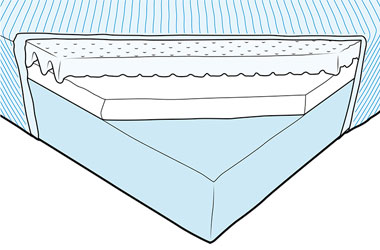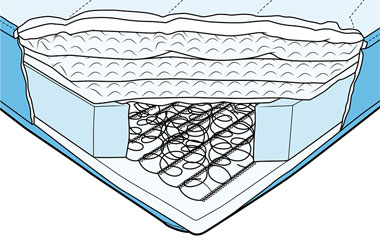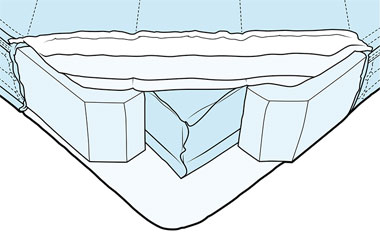Best Mattresses You Can Buy
mattress shopping is awful because we don’t really know what to look for. here’s help.
Every day, we get an email or two asking us, hands down, what is the best mattress, from all of the options we mention and recommend, that we would have delivered to our very own door.
It’s a fair question, considering how exhausting and mindless it is to comb through endless web sites or drift, half asleep, into a giant retail cavern awash in fluorescent light, lying down while Chad the mattress salesman hovers over you with his tie dangling and dancing upon your lips, as if to say, “hush, let me do the talking”.
Mattress shopping sucks, admit it, even though sexy web sites lure us with cute graphics, panoramic pictures of their snowy white mattresses plopped on the floor in some lofty Manhattan high rise with salvaged plank floors and a telescope on the balcony. A rescued greyhound lounges in the foreground. You visit their web site, and for weeks you are bombarded with their ads on Facebook, and every where you go online.
If you despise a trip to Mattress Firm or Macy’s, understand that you have more options than ever before—specialty bedding and department stores are no longer the mandatory destination for mattress grazing. Phenomenal mattresses at fair prices can be found online, and the competition is only getting fiercer, every day. And because of the high level of serious competition out there these days, most retailers have bulletproofed your purchase with no questions asked trial periods, unbelievable return policies, and warranties that were unheard of ten years ago. It’s pretty safe to buy a mattress online, too, because of the importance of good reviews. But, you must know what to look for.
To Find the Best Mattress, You Must Know The Difference Between Mattress Design And Types
If you’re shopping for a new mattress, you could be overwhelmed by the variety of choices and prices, ranging from “there must be something wrong with it” pricing, to insanely astronomical. Thankfully, though, there is a sweet spot beginning to emerge: Our years of experience designing and retailing on our own web sites as well as monitoring mattress pricing across the industry, clearly shows that, whichever type you choose, you only need to spend around $1,000 for a comfortable, supportive mattress. So, here are the major types you’ll see:
Foam Or Foam Hybrid-a great option, the most popular choice when shopping online
Foam and foam hybrids (different kinds of foam sandwiched together in one “cake recipe” stack), are the most popular type of mattress in the industry, and will probably stay that way for a long time, thanks to the diversity and variety of foam layers that can be used to create endless plush to very firm and supportive beds. They can be perfect solutions for those of who suffer from back and joint pain.

Though many manufacturers use highly specialized polyurethane to create their foam layers, some might use latex as well. Latex is wonderfully buoyant and bouncy, and pushes up against your body, cradling while at the same time, levitating your body a bit. We think latex is a magical ingredient in our hypothetical perfect mattress.
Some mattresses include both. Different kinds of foam react very uniquely to your body. Memory foam for example responds by slowly melting up around you and providing very close cradling support.
Memory foam softens when you lie on it and soon molds to your body. Memory foam is the best material you can find for relieving pressure points, spreading your weight laterally. Once you get up, it slowly springs back to its original shape. A few people claim that memory foam makes it more difficult to turn, but if you combine in a hybrid bed with a latex layer, you actually amplify the benefits, because latex is also very pressure relieving, easy to turn on, and compliments the yielding sensation of memory foam. Bottom line, a perfect mattress might very well include both of these materials.
New advances in foam technology has opened up vast categories which can be used for unique purposes to create that perfect mattress. Gel foam technology, which provides a jelly like sensation that yields to pressure without sacrificing support is rapidly advancing. Gel foam spreads weight much like your hands spread pizza dough, off to the side, other than down. Other foams like carbon, charcoal, or graphite infuse foams diffuse heat, and column buckling rubber polymer foam, like those used in the highly popular Purple mattress, is rapidly rising in popularity. Endless hybrid versions of all of these foam components create wonderful opportunities for mattress design and construction for hot sleepers, belly sleepers, flip floppers, even people confined to bed for long periods of time during the day.
Innerspring And Pocketed Coil Hybrids- the age old design has been reinvented and it’s totally awesome
More than 65% of mattresses sold today are still coil, or innerspring mattresses. That’s because innerspring mattresses and the wire workings and coils are entrenched in our minds as the standard guts for any decent bed. And these days, due to the rapid advances in technology of innerspring and coil systems used in today’s variety, there is some truth in that. These traditional mattresses are composed of steel coils in various configurations, with a top layer of foam and various textiles like cotton, bamboo, or other materials, and usually have an edge support system like foam that wraps around the perimeter of the bed. These days, though, coil mattresses can be rolled and shipped just like foam mattresses, and have spawned an entirely new category of beds, called coil hybrids.

Don’t get caught up in the details with coil beds, though. Higher end innerspring models have 600 to 1,000 coils. But even if one mattress has more coils than another, the coils could be made of thinner-gauge metal. You’ll also hear about coil variations such as Bonnell (hourglass type), continuous wire, and individually pocketed springs. None of those is inherently superior.
Most of these mattress options are made using individually pocketed coils, that provide pinpoint pressure relief and support to specific areas of the body making them an ideal sleep surface for people needing relief at very particular spots. Variations can include special layers of cushioning, a pillow top layer, latex, memory foam, and infused gel foam layers. Hybrids can have one or more layers of foam on top of the springs, too.
Shifting positions tends to be easy, but on some models, particularly the ones that don’t have many foam layers, your sleep partner might feel an annoying bounce when you do so. So, the perfect bed? Well, it might have pocketed coils, latex, and memory foam, too. Our thinking though is that because of the advances in foam technology rapidly superseding what can be done with wire sprung coils and metal, even the coils themselves are being replaced with foam “coils” and precise pressure point relief using isolated foam columns, baffling, or cylinders. We think that 10 years from now, it might be difficult to even find a mattress made with metal coil systems.
Adjustable Air Beds- not just sleep number-there are other affordable versions of this tweakable mattress
Not a camping bed with an inflatable foot pump, but the highly sophisticated digital version that is built on an air chamber platform instead of a firm foam base layer or coil system, this kind of mattress is completely adjustable and highly customizable. You can inflate this type of mattress to your desired firmness using a wired or wireless remote control, activating an electric pump attached to the bed. These typically include additional layers on top, such as various foam materials, especially memory foam and latex but relies also on a comfortable and well designed outer fabric piece on top, made using textiles and components that compliment the foam layers and air chamber platform. Most also let you inflate individual sides to different firmnesses to suit each sleep partner.

Bottom Line: We Think A Good Foam Hybrid Mattress Might Be The overall Perfect Option
In our mind, the perfect mattress available today is a foam hybrid, consisting of memory foam, latex, and pocketed coils, with a bamboo or organic top piece. However, you could do without coils and probably be alright. If you can find a foam bed with a graphite layer, we’d say that’s a winner also, especially if you are a hot sleeper. And, if you’ve got a partner, and you like firm, and they like soft, strongly consider an air bed with a memory foam and latex layer.
Try to Haggle And Ask For Freebies
Once you’ve settled on a bed, whether online or in a retail store, try to bring the price down. Get on a chat with a rep and ask for discounts and freebies. Most products, especially in the competitive online marketplace, already have these program built in…all you have to is ask. Many businesses, such as warehouse clubs, have fixed prices and won’t budge. But for retailers that do negotiate—particularly specialty chains—huge markups allow them to lower prices by 50 percent or more during their frequent sales. This goes for online stores too. Our recommendation: Any time of year, insist on a sale price you’ve seen for the mattress you know you want, and don’t be afraid to walk out if you feel you’re being scammed or the price seems outrageous. Again, for a queen size bed, of any kind, use $1,000 as a solid frame of reference for average pricing.
Don’t Be Bullied Into Buying A Foundation Or Box Spring
You might not need it. If your box spring isn’t broken and you can stand on it without any indentation, it’s perfectly fine to use. Strongly consider keeping it and saving money (roughly $250 to $300 for a queen-size). Some brands require you to buy their box spring to receive full warranty coverage, which is nonsense. Ask for the same warranty arrangement without purchasing the foundation if you don’t need it. Many foam manufacturers recommend a platform base or strong slatted wood foundations, and remember to follow the three and three rule we discuss elsewhere. Three inches wide on the slat minimum, and three inches of space between the slats, maximum.